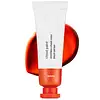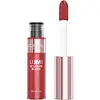What's inside
What's inside
 Key Ingredients
Key Ingredients

 Benefits
Benefits

 Concerns
Concerns

 Ingredients Side-by-side
Ingredients Side-by-side

Water
Skin ConditioningCyclopentasiloxane
EmollientMethyl Trimethicone
Skin ConditioningMica
Cosmetic ColorantButylene Glycol
HumectantPEG-10 Dimethicone
Skin ConditioningDicaprylyl Carbonate
EmollientNeopentyl Glycol Diheptanoate
EmollientDisteardimonium Hectorite
StabilisingGlycerin
HumectantVinyl Dimethicone/Methicone Silsesquioxane Crosspolymer
Sorbitan Isostearate
EmulsifyingSoluble Collagen
HumectantEthylhexylglycerin
Skin ConditioningMagnesium Sulfate
Dimethicone/Vinyl Dimethicone Crosspolymer
Skin ConditioningMethyl Methacrylate Crosspolymer
Triethoxycaprylylsilane
Disodium EDTA
Polyglyceryl-2 Triisostearate
EmulsifyingTocopherol
AntioxidantPentylene Glycol
Skin ConditioningPhenoxyethanol
PreservativeAluminum Hydroxide
EmollientTin Oxide
AbrasiveSilica
AbrasiveKaolin
AbrasiveCI 77891
Cosmetic ColorantIron Oxides
CI 42090
Cosmetic ColorantCI 75470
Cosmetic ColorantCI 77742
Cosmetic ColorantCI 15850
Cosmetic ColorantCI 73360
Cosmetic ColorantCI 17200
Cosmetic ColorantCI 77007
Cosmetic ColorantCI 15985
Cosmetic ColorantWater, Cyclopentasiloxane, Methyl Trimethicone, Mica, Butylene Glycol, PEG-10 Dimethicone, Dicaprylyl Carbonate, Neopentyl Glycol Diheptanoate, Disteardimonium Hectorite, Glycerin, Vinyl Dimethicone/Methicone Silsesquioxane Crosspolymer, Sorbitan Isostearate, Soluble Collagen, Ethylhexylglycerin, Magnesium Sulfate, Dimethicone/Vinyl Dimethicone Crosspolymer, Methyl Methacrylate Crosspolymer, Triethoxycaprylylsilane, Disodium EDTA, Polyglyceryl-2 Triisostearate, Tocopherol, Pentylene Glycol, Phenoxyethanol, Aluminum Hydroxide, Tin Oxide, Silica, Kaolin, CI 77891, Iron Oxides, CI 42090, CI 75470, CI 77742, CI 15850, CI 73360, CI 17200, CI 77007, CI 15985
Water
Skin ConditioningDimethicone
EmollientIsododecane
EmollientButylene Glycol
HumectantAlcohol
AntimicrobialAcrylates/Polytrimethylsiloxymethacrylate Copolymer
Skin ConditioningCetyl PEG/PPG-10/1 Dimethicone
EmulsifyingTrimethyl Pentaphenyl Trisiloxane
EmollientSynthetic Fluorphlogopite
Disteardimonium Hectorite
StabilisingPolyglyceryl-4 Isostearate
EmulsifyingMagnesium Sulfate
Phenoxyethanol
PreservativePropylene Carbonate
SolventPEG/PPG-18/18 Dimethicone
EmulsifyingSilica
AbrasiveTin Oxide
AbrasiveCalcium Aluminum Borosilicate
Disodium Stearoyl Glutamate
CleansingAluminum Hydroxide
EmollientPentaerythrityl Tetra-Di-T-Butyl Hydroxyhydrocinnamate
AntioxidantTocopherol
AntioxidantMica
Cosmetic ColorantCI 77891
Cosmetic ColorantCI 77491
Cosmetic ColorantCI 77499
Cosmetic ColorantCI 15850
Cosmetic ColorantCI 15985
Cosmetic ColorantCI 19140
Cosmetic ColorantCI 77510
Cosmetic ColorantWater, Dimethicone, Isododecane, Butylene Glycol, Alcohol, Acrylates/Polytrimethylsiloxymethacrylate Copolymer, Cetyl PEG/PPG-10/1 Dimethicone, Trimethyl Pentaphenyl Trisiloxane, Synthetic Fluorphlogopite, Disteardimonium Hectorite, Polyglyceryl-4 Isostearate, Magnesium Sulfate, Phenoxyethanol, Propylene Carbonate, PEG/PPG-18/18 Dimethicone, Silica, Tin Oxide, Calcium Aluminum Borosilicate, Disodium Stearoyl Glutamate, Aluminum Hydroxide, Pentaerythrityl Tetra-Di-T-Butyl Hydroxyhydrocinnamate, Tocopherol, Mica, CI 77891, CI 77491, CI 77499, CI 15850, CI 15985, CI 19140, CI 77510
 Reviews
Reviews

Ingredients Explained
These ingredients are found in both products.
Ingredients higher up in an ingredient list are typically present in a larger amount.
Aluminum Hydroxide is a form of aluminum. It can be naturally found in nature as the mineral gibbsite. In cosmetics, Aluminum Hydroxide is used as a colorant, pH adjuster, and absorbent.
As a colorant, Aluminum Hydroxide may add opacity, or reduce the transparency. Aluminum hydroxide is contains both basic and acidic properties.
According to manufacturers, this ingredient is an emollient and humectant. This means it helps hydrate the skin.
In medicine, this ingredient is used to help relieve heartburn and help heal ulcers.
There is currently no credible scientific evidence linking aluminum hydroxide in cosmetics to increased cancer risk.
Major health organizations allow the use of aluminum hydroxide in personal care products and have not flagged it as a carcinogenic risk at typical usage levels.
Learn more about Aluminum HydroxideButylene Glycol (or BG) is used within cosmetic products for a few different reasons:
Overall, Butylene Glycol is a safe and well-rounded ingredient that works well with other ingredients.
Though this ingredient works well with most skin types, some people with sensitive skin may experience a reaction such as allergic rashes, closed comedones, or itchiness.
Learn more about Butylene GlycolCi 15850 is the pigment color red. It is an azo dye and created synthetically.
Azo dyes need to be thoroughly purified before use. This allows them to be more stable and longer-lasting.
This ingredient is common in foundations, lipsticks, and blushes. This color is described as brown/orangey red.
It has many secondary names such as Red 6 and Red 7. According to a manufacturer, Red 6 usually contains aluminum.
Learn more about CI 15850Ci 15985 is a dye made from petroleum. It is synthetically created and approved by the FDA for use in foods and cosmetics.
The color of this dye is orange/yellow.
This ingredient can be found in makeup, sun care, and skincare.
Learn more about CI 15985Ci 77891 is a white pigment from Titanium dioxide. It is naturally found in minerals such as rutile and ilmenite.
It's main function is to add a white color to cosmetics. It can also be mixed with other colors to create different shades.
Ci 77891 is commonly found in sunscreens due to its ability to block UV rays.
Learn more about CI 77891Disteardimonium Hectorite comes from the clay mineral named hectorite. It is used to add thickness to a product.
It can also help stabilize a product by helping to disperse other ingredients.
Hectorite is a rare, white clay mineral.
Learn more about Disteardimonium HectoriteMagnesium Sulfate is a salt. More specifically, it is an epsom salt, or the bath salt used to help relieve muscle aches.
Despite having ‘sulfate’ in the name, it isn’t a surfactant or cleansing agent like sodium lauryl sulfate. Unlike those sulfates, magnesium sulfate doesn’t have the same cleansing or foaming properties (it's simply a type of salt).
In cosmetics, Magnesium Sulfate is used to thicken a product or help dilute other solids. It is a non-reactive and non-irritating ingredient.
One study shows magnesium deficiency may lead to inflammation of the skin. Applying magnesium topically may help reduce inflammation.
You can find this ingredient in sea water or mineral deposits.
Learn more about Magnesium SulfateMica is a naturally occurring mineral used to add shimmer and color in cosmetics. It can also help improve the texture of a product or give it an opaque, white/silver color.
Serecite is the name for very fine but ragged grains of mica.
This ingredient is often coated with metal oxides like titanium dioxide. Trace amounts of heavy metals may be found in mica, but these metals are not harmful in our personal products.
Mica has been used since prehistoric times throughout the world. Ancient Egyptian, Indian, Greek, Roman, Aztec, and Chinese civilizations have used mica.
Learn more about MicaPhenoxyethanol is a preservative that has germicide, antimicrobial, and aromatic properties. Studies show that phenoxyethanol can prevent microbial growth. By itself, it has a scent that is similar to that of a rose.
It's often used in formulations along with Caprylyl Glycol to preserve the shelf life of products.
Silica, also known as silicon dioxide, is a naturally occurring mineral. It is used as a fine, spherical, and porous powder in cosmetics.
Though it has exfoliant properties, the function of silica varies depending on the product.
The unique structure of silica enhances the spreadability and adds smoothness, making it a great texture enhancer.
It is also used as an active carrier, emulsifier, and mattifier due to its ability to absorb excess oil.
In some products, tiny microneedles called spicules are made from silica or hydrolyzed sponge. When you rub them in, they lightly polish away dead skin layers and enhance the penetration of active ingredients.
Learn more about SilicaTin Oxide is an inorganic oxide used to add opacity and volume to a product. In nature, it is already found in mineral form. The main ore of tin is an opaque and shiny mineral called casseterite.
Tin Oxide helps remove translucency in a product, or make it more opaque. Besides adding opacity, tin oxide is used for bulking to add volume.
Tocopherol (also known as Vitamin E) is a common antioxidant used to help protect the skin from free-radicals and strengthen the skin barrier. It's also fat soluble - this means our skin is great at absorbing it.
Vitamin E also helps keep your natural skin lipids healthy. Your lipid skin barrier naturally consists of lipids, ceramides, and fatty acids. Vitamin E offers extra protection for your skin’s lipid barrier, keeping your skin healthy and nourished.
Another benefit is a bit of UV protection. Vitamin E helps reduce the damage caused by UVB rays. (It should not replace your sunscreen). Combining it with Vitamin C can decrease sunburned cells and hyperpigmentation after UV exposure.
You might have noticed Vitamin E + C often paired together. This is because it is great at stabilizing Vitamin C. Using the two together helps increase the effectiveness of both ingredients.
There are often claims that Vitamin E can reduce/prevent scarring, but these claims haven't been confirmed by scientific research.
Learn more about TocopherolWater. It's the most common cosmetic ingredient of all. You'll usually see it at the top of ingredient lists, meaning that it makes up the largest part of the product.
So why is it so popular? Water most often acts as a solvent - this means that it helps dissolve other ingredients into the formulation.
You'll also recognize water as that liquid we all need to stay alive. If you see this, drink a glass of water. Stay hydrated!
Learn more about Water